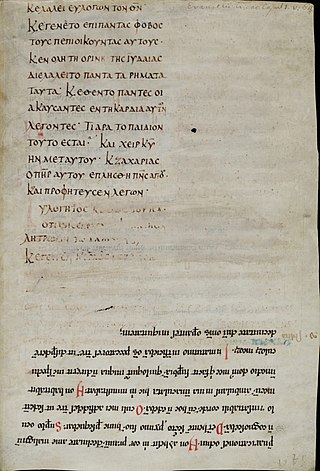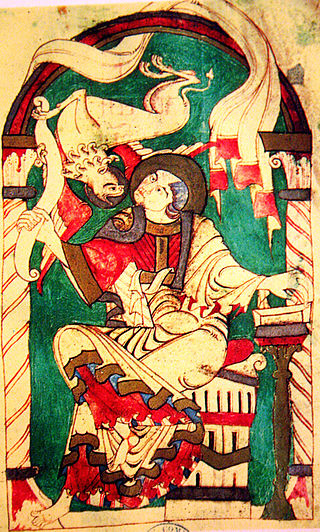Related Research Articles

Codex Claromontanus, symbolized by Dp, D2 or 06 (in the Gregory-Aland numbering), δ 1026 (von Soden), is a Greek-Latin diglot uncial manuscript of the New Testament, written in an uncial hand on vellum. The Greek and Latin texts are on facing pages, thus it is a "diglot" manuscript, like Codex Bezae Cantabrigiensis. The Latin text is designated by d (traditional system) or by 75 in Beuron system.
The Garland of Howth, also known as the Codex Usserianus Secundus, designated by r2 or 28, is a fragmentary 8th to 10th century Latin Gospel Book in the possession of Trinity College Dublin as MS. 56.
Codex Dublinensis designated by Z or 035, ε 26, is a Greek uncial manuscript of the Gospels, dated palaeographically to the 6th century. The manuscript is lacunose.
Codex Vaticanus Graecus 2061, usually known as Uncial 048, α1 (Soden), is a Greek uncial manuscript on parchment. It contains some parts of the New Testament, homilies of several authors, and Strabo's Geographica. Formerly it was known also as the Codex Basilianus 100, earlier as Codex Patriniensis 27. It was designated by ב a, p.

Uncial 0130, ε 80 (Soden), is a Greek uncial manuscript of the New Testament, dated palaeographically to the 9th-century. Formerly it was labelled by Wc.
Uncial 0133, ε 83 (Soden), is a Greek uncial manuscript of the New Testament, dated paleographically to the 9th century. Formerly it was labelled by Wg.
Uncial 0135, ε 85 (Soden), is a Greek uncial manuscript of the New Testament, dated paleographically to the 9th century.
Lectionary 25, designated by siglum ℓ25 is a Greek manuscript of the New Testament, on vellum leaves. Palaeographically it has been assigned to the 13th-century.
Minuscule 293, ε 365 (Soden), is a Greek minuscule manuscript of the New Testament, on parchment. It is dated by a colophon to the year 1262. Scrivener wrongly deciphered this as November 1373. It has marginalia.
Minuscule 395, ε 216 (Soden), is a Greek minuscule manuscript of the New Testament, on parchment. Paleographically it has been assigned to the 12th century. It contains marginalia.
The Codex Vindobonensis Lat. 1235, designated by i or 17, is a 6th-century Latin Gospel Book. The manuscript contains 142 folios. The text, written on purple dyed vellum in silver ink, is a version of the old Latin. The Gospels follow in the Western order.

The Codex Veronensis, designated by the siglum b or 4, is a 5th-century Latin manuscript of the four Gospels, written on vellum which has been dyed purple. The text is written in silver and occasionally gold ink, and is a version of the old Latin New Testament Gospels. The Gospels follow in the Western order.
The Codex Palatinus, designated by e or 2, is a 5th-century Latin Gospel Book. The text, written on purple dyed vellum in gold and silver ink, is a version of the old Latin. Most of the manuscript was in the Austrian National Library at Vienna until 1919, when it was transferred to Trento, where it is now being kept as Ms 1589 in the Library of Buonconsiglio Castle. Two leaves were separated from the manuscript in the 18th century: one is now in the library of Trinity College, Dublin, the other in the British Library in London.

The Codex Corbeiensis I, designated by ff1 or 9, is an 8th, 9th, or 10th-century Latin New Testament manuscript. The text, written on vellum, is a version of the old Latin. The manuscript contains 39 parchment folios with the text of the four Gospels, Acts of the Apostles, and General epistles.
The Codex Corbeiensis II, designated by ff2 or 8, is a 5th-century Latin Gospel Book. The text, written on vellum, is a version of the old Latin. The manuscript contains 190 parchment folio with the text of the four Gospels with lacunae. Written in a beautiful round uncial hand.
The Codex Curiensis known also as Fragmenta Curiensia, designated by a2 or 16, is a 5th-century AD Latin manuscript of the New Testament. The text, written on vellum, is a version of the old Latin. The manuscript contains the fragments of the Gospel of Luke, on exactly two parchment leaves.
The Codex Mediolanensis or Fragmentum Mediolanense, designated by g2 or 52, is a 10th- or 11th-century Latin manuscript of the New Testament. The text, written on vellum, is a version of the Vetus Latina. The manuscript contains the fragments of the Gospel of Luke, on only 2 parchment leaves. It was a lectionary.

Codex Carolinus is an uncial manuscript of the New Testament on parchment, dated to the 6th or 7th century. It is a palimpsest containing a Latin text written over a Gothic one. The Gothic text is designated by siglum Car, the Latin text is designated by siglum gue or by 79, it represents the Old Latin translation of the New Testament. It is housed in the Herzog August Library in Wolfenbüttel in Lower Saxony, Germany.
The Codex Floriacensis, designated by h in traditional system or by 55 in the Beuron system, is a 6th-century Latin manuscript of the New Testament. The text, written on vellum, is a palimpsest. Another name of the manuscript is Fleury Palimpsest or Palimpsestus Floriacensis. It is one of the eight Old-Latin manuscripts with text of Apocalypse.
The León Palimpsest, designated l or 67, is a 7th-century Latin manuscript pandect of the Christian Bible conserved in the cathedral of León, Spain. The text, written on vellum, is in a fragmentary condition. In some parts it represents the Old Latin version, while following Jerome's Vulgate in others. The codex is a palimpsest.
References
- ↑ Bruce M. Metzger, The Early Versions of the New Testament, Oxford University Press, 1977, p. 300.
- 1 2 Gregory, Caspar René (1902). Textkritik des Neuen Testaments, Vol. 2. Leipzig. p. 607. ISBN 1-4021-6347-9.
{{cite book}}: CS1 maint: location missing publisher (link) - ↑ Scrivener, Frederick Henry Ambrose; Miller, Edward (1894). A Plain Introduction to the Criticism of the New Testament, Vol. 2 (4 ed.). London: George Bell & Sons. p. 51.
- ↑ "Burgerbibliothek Bern". Archived from the original on 2016-07-18. Retrieved 2019-12-19.